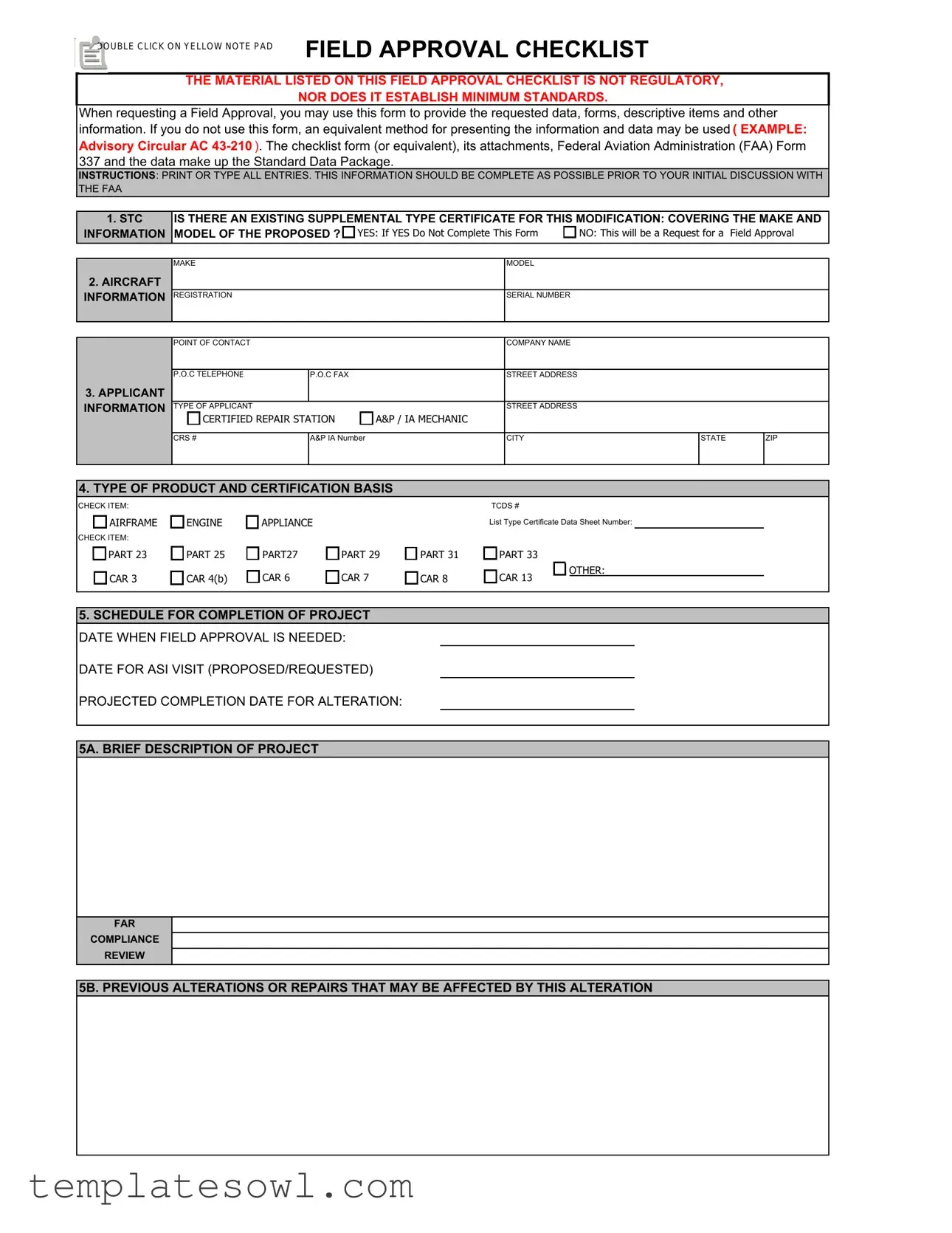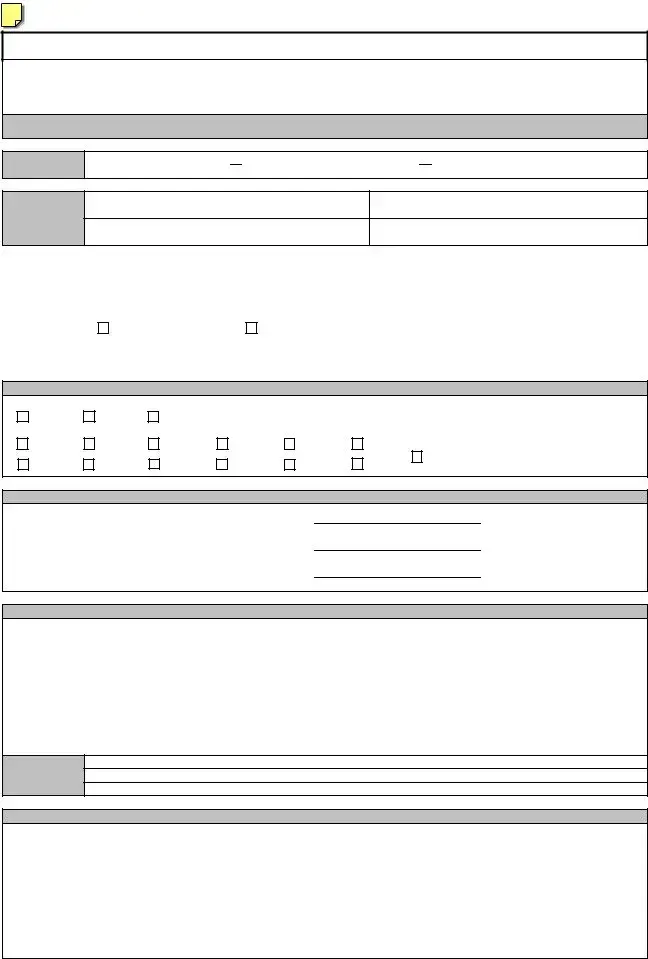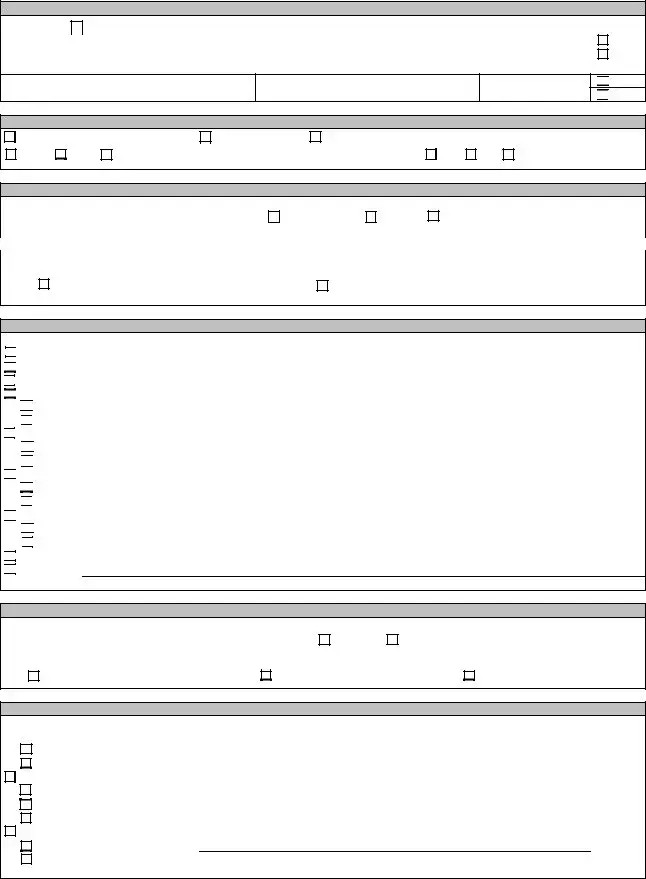What is the purpose of the Field Approval Checklist form?
The Field Approval Checklist form is designed to facilitate the submission of data and information required for obtaining a Field Approval from the FAA. It helps outline critical aspects of the modification or alteration being requested, ensuring that all necessary details are provided for review.
Do I need to use this specific checklist form for my Field Approval request?
While it’s preferred to use this specific checklist form, you can present the required information in another manner, such as referencing the Advisory Circular AC 43-210. Any equivalent method that fully outlines the necessary data will be acceptable.
What information is required on the checklist?
The checklist requires comprehensive details, including the model and serial number of the aircraft, applicant information, description of the project, and details about any existing supplemental type certificate. It also requests information about any relevant previous alterations or repairs that could be affected by the new modification.
What happens if there is an existing Supplemental Type Certificate (STC) for the modification?
If there is an existing STC covering the modification for your aircraft's make and model, you do not need to complete the Field Approval Checklist form. Instead, you can proceed with referencing the existing STC for your modifications.
How should I complete the checklist form?
Ensure that all entries on the checklist are printed or typed clearly. Aim to provide as complete information as possible before your first discussion with the FAA. Incomplete information may delay the approval process.
What attachments are needed with the checklist submission?
Several attachments may be necessary, including FAA Form 337 for the alteration, previously approved FAA Form 337 copies, and any relevant drawings, test data, or instructions for continued airworthiness. Refer to the checklist to ensure you include all applicable documentation.
Will I need to provide an Aircraft Flight Manual Supplement (AFMS)?
Determine if your alteration will require an AFMS. If yes, you will need to attach a copy of the AFMS to your submission along with the checklist form.
What if my aircraft has undergone previous alterations?
If your aircraft has had prior alterations or repairs that could potentially impact the new alteration, you are required to list these on the checklist. This ensures a thorough review and assessment of the cumulative effect on the aircraft's performance and safety.
What should I do if I'm unsure about specific requirements related to my alteration?
If uncertainties arise regarding the requirements or processes for your alteration, consult directly with the FAA. Engaging with them early can provide clarity and help ensure you meet all necessary obligations before submission.


 DOUBLE CLICK ON YELLOW NOTE PAD
DOUBLE CLICK ON YELLOW NOTE PAD 



 DER
DER
 DAR
DAR
 FAA FORM 337 FOR THE ALTERATION PROPOSED
FAA FORM 337 FOR THE ALTERATION PROPOSED
 COPIES OF OTHER PREVIOUSLY APPROVED FAA FORM 337 (SUPPORTING DATA)
COPIES OF OTHER PREVIOUSLY APPROVED FAA FORM 337 (SUPPORTING DATA)

 COPY OF SUPPLEMENTAL TYPE CERTIFICATE (STC) (SUPPORTING DATA)
COPY OF SUPPLEMENTAL TYPE CERTIFICATE (STC) (SUPPORTING DATA)
 DRAWINGS,SCHEMATICS & DIAGRAMS
DRAWINGS,SCHEMATICS & DIAGRAMS
 ELECTRICAL DRAWINGS
ELECTRICAL DRAWINGS
 STRUCTURAL DRAWINGS
STRUCTURAL DRAWINGS

 SUPPORTING TEST DATA
SUPPORTING TEST DATA
 EMI/RFI PROCEDURES
EMI/RFI PROCEDURES
 GROUND TEST PROCEDURES
GROUND TEST PROCEDURES
 LOAD ANALYSIS
LOAD ANALYSIS
 ELECTRICAL
ELECTRICAL
 STRUCTURAL
STRUCTURAL
 FAA FORM
FAA FORM 
 ELECTRICAL
ELECTRICAL
 STRUCTURAL
STRUCTURAL
 PLACARDS (COPY OF EXACT VERBIAGE)
PLACARDS (COPY OF EXACT VERBIAGE)
 OTHER
OTHER